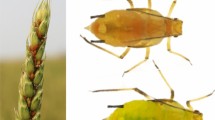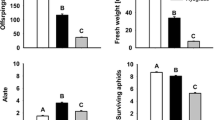Abstract
We examined body color polymorphism in the aphidMacrosiphoniella yomogicola from July to September 1993. We classified body color into eight types: green 1, green 2, red 1, red 2, white, orange, yellow and mist. The frequencies of body color varied with time and among patches of the host plant, yomogi (Artemisia spp.). Color diversity within a shoot was calculated using the Shannon diversity index. Of five usable data sets, three showed negative relationships between color diversity and mortality. The regression coefficients for two of these relationships were significant. No significant relationship between mortality and the number of aphids was found. The color diversity was not significantly related to a particular body color found on a yomogi shoot. Color polymorphism may be maintained because selection may favor a high color diversity on the host plant shoot.
Similar content being viewed by others
References
Crawley M. J. (1993)GLIM for Ecologists. Blackwell Science, Oxford.
Dixon A. G. F. (1972) Control and significance of the seasonal development of colour forms in sycamore aphid,Drepanosiphum platonoides (Schr.).Journal of Animal Ecology 41: 689–697.
Dixon A. G. F. (1985)Aphid Ecology. Chapman & Hall, New York.
Futuyma D. J. (1986)Evolutionary Biology. Sinauer, Sunderland.
Grayson J. &Edmunds M. (1989) The causes of colour and colour change in caterpillars of the poplar and eyed hawkmoths (Laothoe populi andSmerinthus ocellata).Biological Journal of the Linnean Society 37: 263–279.
Hails R. S. &Crawley M. J. (1992) Spatial density dependence in populations of cynipid gall-formerAndricus quercuscalicis.Journal of Animal Ecology 61: 567–583.
Markkula M. (1963) Studies on the pea aphid,Acrythosiphom pisum Harris (Hom., Aphididae) with special reference to the difference in biology of the green and red forms.Annales Agriculturae Fennial Supplementum 2: 1–30.
Miyazaki M. (1987) Forms and Morphs of Aphids In:Aphids Their Biology, Natural Enemies and Control, vol. A (eds A. K. Minks & P. Harrewijn) pp. 27–50. Elsevier, Amsterdam.
Pietrewicz A. T. &Kamil A. G. (1981) Search images and the detection of cryptic prey: An operant approach In:Foraging Behavior: Ethological and Psychological Approaches (eds A. G. Kamil & T. D. Sargent) pp. 311–332. Garland STPM Press, New York.
Reichmuth W. &Klink G. (1961) Über die Licht- und Temperaturabhängigkeit der Ausbildung eines photolabilen Farbstoffers sowie Beziehungen zwischen Farbstoffgehalt und Insektizidverträglichkeit bei Doralis fabae Scop.Biologisches Zentralbatt 80: 281–299.
Rice W. R. (1989) Analyzing tables of statistical tests.Evolution 43: 223–225.
Shannon C. E. &Weaver W. (1963)The Mathematical Theory of Communication. University of Illinois Press, Urbana.
Ueda N. &Tanaka H. (1977) Differential relative abundance of green-yellow and red forms ofMyzus persicae (Sulzer) (Homoptera: Aphidiae) according to host plant and season.Applied Entomology and Zoology 12: 124–270.
Author information
Authors and Affiliations
About this article
Cite this article
Agawa, H., Kawata, M. The effect of color polymorphism on mortality in the aphidMacrosiphoniella yomogicola . Ecol. Res. 10, 301–306 (1995). https://doi.org/10.1007/BF02347856
Received:
Accepted:
Issue Date:
DOI: https://doi.org/10.1007/BF02347856




